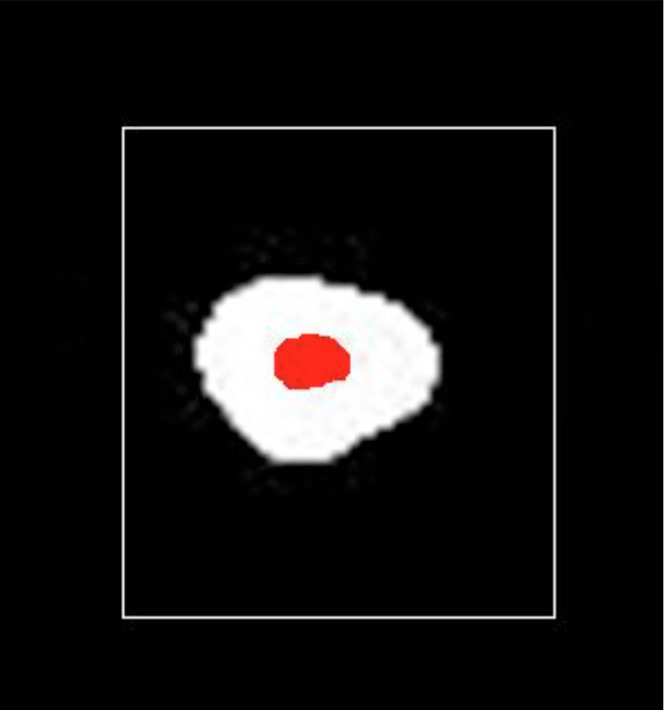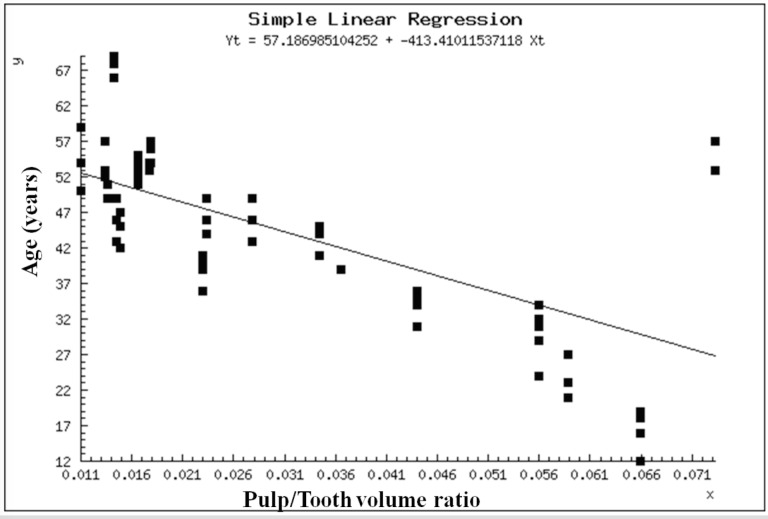Abstract
The present study assessed the suitability of pulp/tooth volume ratio of mandibular canines for age prediction in an Indian population. Volumetric reconstruction of scanned images of mandibular canines from 140 individuals (aged ten - 70 years), using computed tomography was used to measure pulp and tooth volumes. Age calculated using a formula reported earlier for a Belgian sample, resulted in errors > ten years in almost 86% of the study population. The regression equation obtained for the Indian population: Age = 57.18 + (- 413.41 x pulp/tooth volume ratio), was applied to an independent control group (n = 48), and this resulted in mean absolute errors of 8.54 years which was significantly (p < 0.05) lower than those derived with the Belgian formula. The pulp/tooth volume ratio is a useful indicator of age, although correlations may vary in different populations and hence, specific formulae should be applied for the estimates.
Keywords: Forensic science, forensic odontology, age estimation, Indian, pulp volume, tooth volume, cone beam computed tomography
INTRODUCTION
The identification of age in anthropology and forensic medicine is sometimes difficult, but nonetheless important. Several methods based on the analysis of teeth have been reported in the literature to estimate the unknown age of individuals. The most widely used methods include the analyses of Gustafson (1) and Johanson, (2) as well as the assessment of dentinal translucency (3) and of cementum annulations. (4, 5) Some methods are destructive and are therefore not appropriate for living individuals. In anthropology, (6) the analysis of dental wear (7) is the most commonly used method.
Examination of the pulp space offers new opportunities in dental age identification. A commonly used method found to be effective is the evaluation of secondary dentine apposition. (8) This apposition is a continuous, age-associated process, which alters the size of the pulp chamber and is only modified under pathological conditions (for example, caries). Various methods have been developed to study the size of the pulp chamber, including tooth crosssections and radiographs. Both panoramic (8) and periapical radiographs (9) have been used to assess the pulp/tooth area ratio of maxillary canines. The primary disadvantage of radiographs is that they are two-dimensional projections which are subject to considerable magnification and distortional errors. Therefore, a simultaneous assessment of the mesio-distal and bucco-lingual dimensions of teeth has been recommended. Computed tomography (CT) is the ideal and most accurate method to evaluate the pulp/tooth volume ratio (10) and a previous study reported on dental age estimation based on microfocus CT images of extracted teeth. (11)
Internal complexities of the root canal seem to be genetically determined and are considered important in anthropology (12) and the same can be expected to apply to the relative proportion of the pulp and tooth volumes. However, there are very few reports on the use of CT to determine the pulp/tooth volume ratio of different populations so that a valuable data set is missing for forensic medicine. An extensive review of literature showed that there was only one report on the use of Cone Beam Computed Tomography (CBCT) to determine the pulp/tooth volume and correlate it to age. (10) Therefore, the aim of the present study was to analyze the pulp/tooth volume ratio of canines in an Indian population by CBCT and correlate it to age. The null hypothesis was that there is no such correlation.
MATERIALS AND METHODS
One hundred and eighty-eight intact, noncarious mandibular canines were collected from dental practitioners across the Indian subcontinent. The age of the subjects ranged between ten and 70 years and was evenly distributed across different age groups (Table 1). Subjects were divided into a study sample of 140 individuals and a control group of 48, taking care that age-distribution was similar in both groups. All teeth were obtained from indigenous Indians and no specimens from other ethnic minorities were included. The process of collection was performed by a team of practitioners (who were informed about the aims of the study) and every tooth was accompanied by a case record stating the ethnicity and age of the patients. Carious teeth, teeth with restorations and excessive wear were excluded. The teeth were washed under tap water immediately after extraction and stored in distilled water with thymol iodide crystals (Titan Pharma, Mumbai, India) until the collection was completed after about two months. Then the specimens were washed thoroughly under tap water and immersed in 2.5% sodium hypochlorite (Prime Dental Products, Mumbai, India) for 30 minutes to remove adherent soft tissue.
Table 1. Sample distribution across age-groups and sexes.
| Age group (years) | Males | Females | Total |
|---|---|---|---|
| Study group | |||
| 10-20 | 04 | 03 | 07 |
| 21-30 | 11 | 11 | 22 |
| 31-40 | 15 | 13 | 28 |
| 41-50 | 14 | 13 | 27 |
| 51-60 | 14 | 13 | 27 |
| >60 | 15 | 14 | 29 |
| Total | 73 | 67 | 140 |
| Control group | |||
| 10-20 | 4 | 4 | 8 |
| 21-30 | 4 | 4 | 8 |
| 31-40 | 4 | 4 | 8 |
| 41-50 | 4 | 4 | 8 |
| 51-60 | 4 | 4 | 8 |
| >60 | 4 | 4 | 8 |
| Total | 24 | 24 | 48 |
| Grand total | 97 | 91 | 188 |
All the teeth were imaged by a Cone Beam Computed Tomography scanner (3DAccuitomo, J Morita Corporation, Osaka, Japan) with a constant slice thickness of 250 µm and exposure conditions of 140 kV and 550 mA. The scans were evaluated using both cross-sections and longitudinal sections. Volume rendering and multiplanar volume reconstruction (Fig. 1) was performed with the Advantage Windows workstation (GE Systems, USA). Using a method described previously (10) the pulp/tooth volume ratio was determined by two independent examiners who were blinded with regard to personal data of the patients (Fig. 2, 3, 4). Age was then calculated using the linear regression equation derived by Yang et al. for mandibular canines. (10)
Fig. 1.
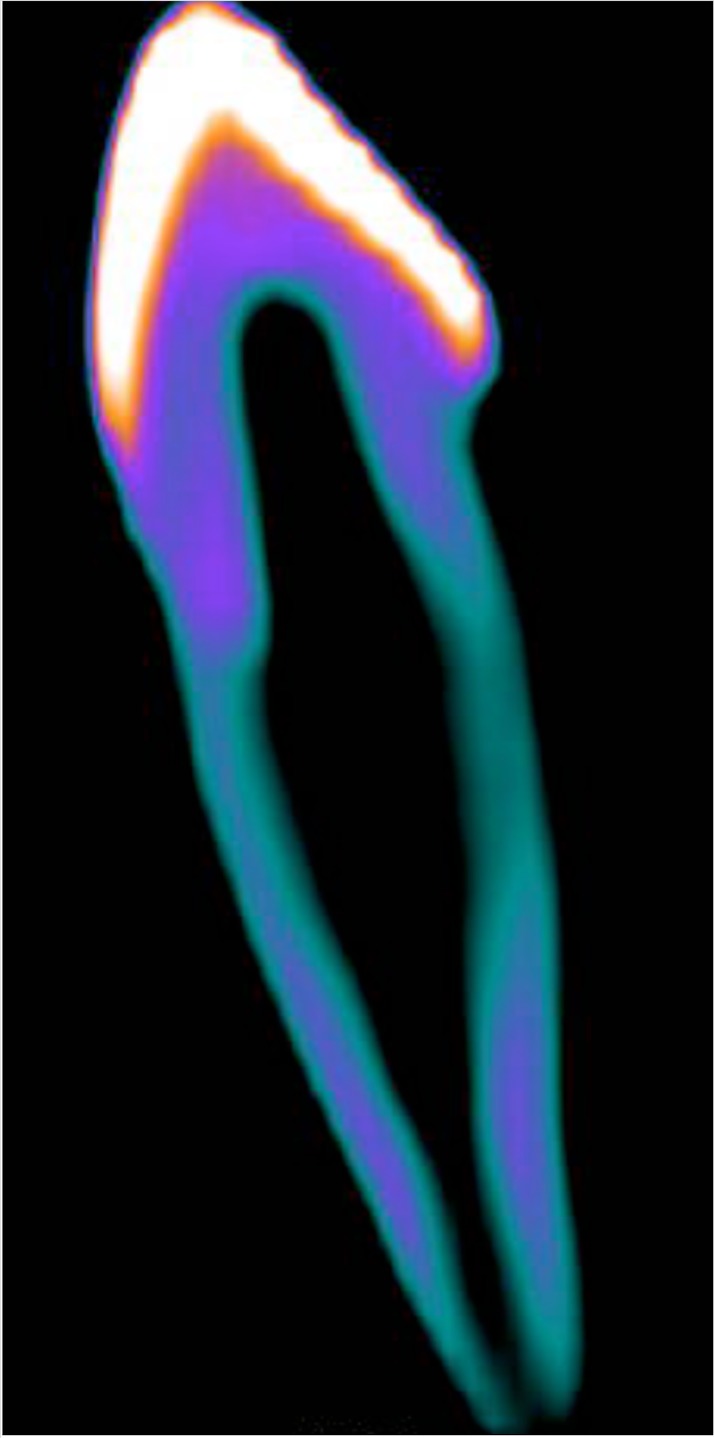
Reconstructed CT image of tooth with tooth volume marked.
Fig. 2.
A cross-sectional slice of the tooth obtained by CT, outlining the pulp space.
Fig. 3.
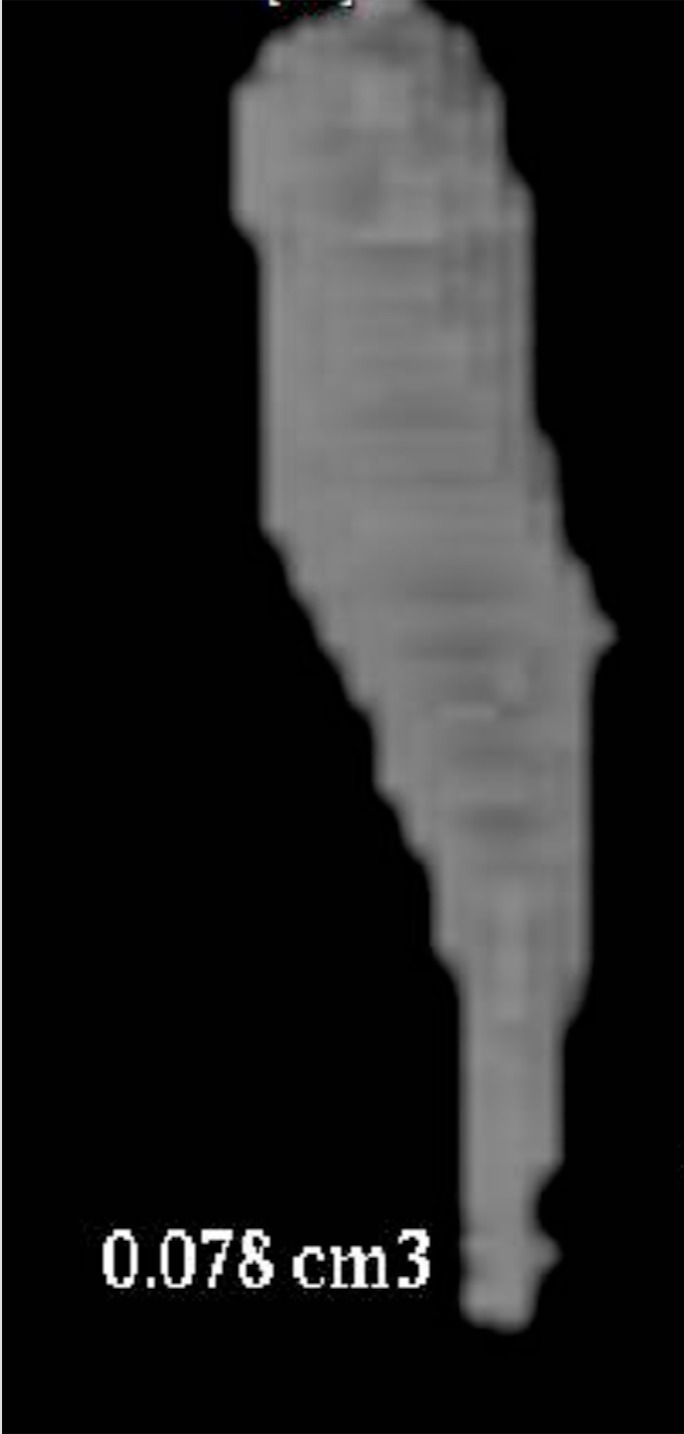
Volumetric reconstruction of pulp space.
Fig. 4.
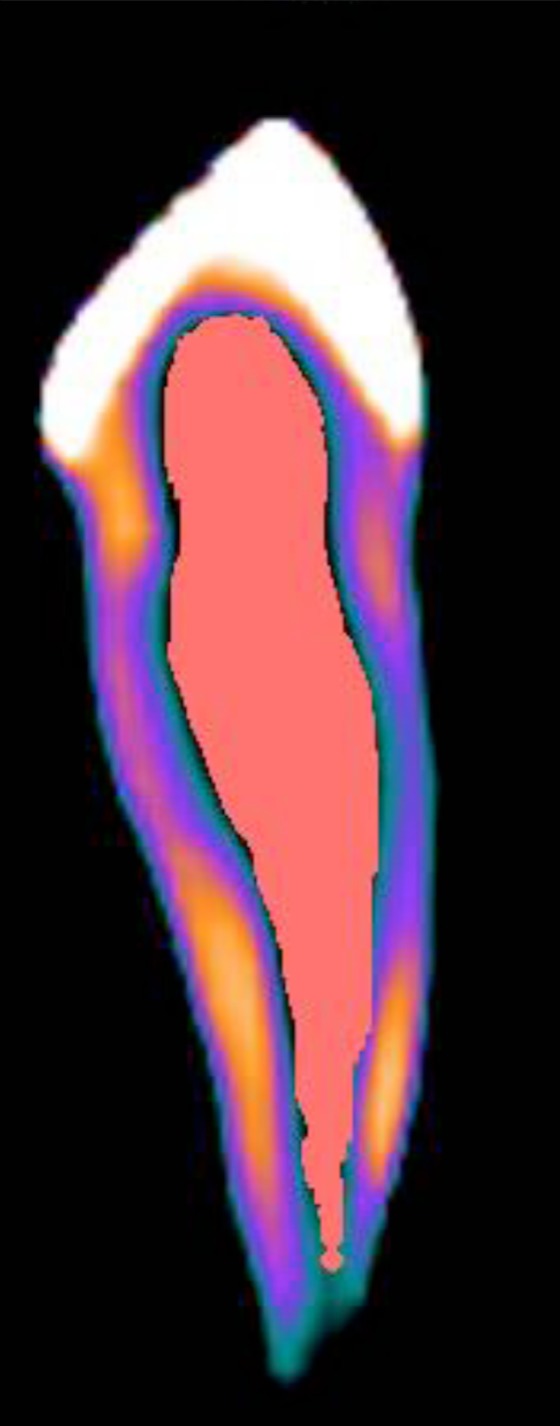
Superimposition of pulp volume reconstruction on tooth volume image.
All the results from the measurements along with additional information such as: type of tooth (right or left canines) and the individual’s age and gender, were entered in a spreadsheet (Microsoft Excel 2007). Inter-rater agreement (reproducibility) was determined using the data of the two examiners. Intra-rater agreement (repeatability) was assessed by having both the examiners evaluate one half of the CBCT images at two separate sessions. Results from repeated measurements were subjected to a paired t-test to assess potential systematic intra- and inter-observer errors. The intraclass correlation coefficient was calculated to estimate the reliability of the measurements recorded by the two examiners. In addition, the size of the measurement errors was calculated as √(SUM(d (2))/2N), where d are the differences between double measurements and N the number of double measurements. From the differences between the actual and predicted ages the mean absolute error (MAE) was calculated to obtain a measure of the accuracy of the age prediction. (13) For the same purpose, the percentage of estimates with deviations of more than ± ten years, which is considered as ‘‘acceptable’’ in forensic age prediction, (14) was also determined.
As this analysis yielded unexpectedly large errors, a linear regression analysis was performed with the pulp/tooth volume ratios and ages obtained from the Indian sample (SPSS 10.0, SPSS Inc., Chicago, IL, USA). The regression equation so derived was then applied to the control sample (n = 48) to estimate ages and determine the errors of the estimates as described above. The two data sets obtained from the study and control group finally allowed comparisons of the accuracy of the age predictions with the Indian and Belgian formulae. (10)
RESULTS
Differences between repeated measurements at two time points and of different examiners were not statistically significant (p > 0.05). There were no significant differences between the samples in terms of type of tooth (right or left canines) or gender of patients. The value of the intraclass correlation coefficient was very high (ρ=0.99). Measurement errors produced with analyses in two separate sessions and of the two examiners were 0.75 and 1.23 respectively. The use of the formula established for the Belgian population (10) in the study group produced an MAE of 15.34 years in 72.81% of the cases. Age estimates were within ±10 years of actual age in 27.09% of the cases.
Regression analysis yielded a statistically significant but moderate negative correlation between pulp/tooth volume ratio and age (Pearson’s correlation coefficient r = -0.63; p < 0.05; Fig 5) and the following linear regression equation: Age = 57.18 + (- 413.41 x PTV), where PTV is the pulp/tooth volume ratio. Application of this formula to the control group yielded an MAE of 8.54 years with 29/40 (72.5%) estimates lying within ± ten years of actual age. In contrast, the use of Yang’s formula (10) in the control group produced an MAE of 14.78 years, which was significantly different (p < 0.05) from the MAE obtained with our new formula.
Fig. 5.
Graphical representation of age as a function of the pulp/tooth volume ratio.
DISCUSSION
This study indicates that the pulp/tooth volume ratio of human mandibular canines is useful for age predictions, but that respective formulae vary between different populations and have to be adapted: in this case for the Indian population. The use of morphological characteristics of the teeth is considered to yield more reliable age estimates than most other methods. (15) The assessment of pulp/tooth area ratio and pulp/tooth volume ratio are methods to indirectly quantify secondary dentine deposition. Secondary dentine deposition is an ageassociated process along internal tooth surfaces which can be considered well protected against environmental influences. Consequently, evaluation of this parameter may have the potential to eliminate at least part of the effects of external factors.
An earlier report on the application of pulp/tooth area (rather than volume) ratio to estimate age concluded that the formula which had been derived for an Italian population could be applied to Indians as well. (16) However, the results of our study do not support this conclusion, but rather suggest that a formula devised for one population may not be applicable for another. This may be due to anthropological differences between various ethnic populations, but could also be attributed to the fact that pulp/tooth area ratios are calculated from radiographs, which are two-dimensional representations of a threedimensional object.
Cone Beam Computed Tomography (CBCT) was used to calculate the pulp/tooth volume ratio in our study, for two reasons: (1) The analysis of the volumes of the pulp chamber and tooth is more reliable than calculation of area ratios, possibly because secondary dentine formation may not be uniform along all pulp surfaces and, hence, measurements of projected areas could give an incorrect impression of the extent of this process; (2) CBCT is an accurate technique for studying the anatomy of the pulp chamber and root canal system (17) which provides three-dimensional volumetric information of the teeth of living individuals by a single scan and can be operated non-destructively. A similar method has been used for age identification of a Belgian population. (10) The results of this present study show that the formula, though accurate for the Belgian population, did not hold true for the Indian subjects, yielding errors of age estimates exceeding ten years, which is considered unacceptable in forensic age identification. (18) The Indian population is generally considered to be a hybrid of several ethnic groups with characteristics of Caucasian, Mongoloid and Negroid races, which is generally referred to as the Dravidian group. (19) If anthropological differences also existed with respect to the relationship between the pulp/tooth volume ratio and age, these could account for the different outcomes of age predictions in the Belgian and Indian population and further justify the use of population-specific equations. (20) In fact, the correlation derived from the data of our Indian sample was much higher than that demonstrated in the previous report. (10)
CONCLUSION
The present work showed that with a modification of Yang’s formula acceptable age predictions are possible for the Indian population using pulp/tooth volume ratio measurements (of mandibular canines) from Cone Beam Computed Tomography. However, caution should be exercised when extrapolating these results to practical applications. Further research including different types of teeth, thus facilitating the development of multiple regression models could possibly enhance age prediction; additionally further studies should also analyze the possible impact of wear and tertiary dentine deposition on the pulp/tooth volume ratio.
ACKNOWLEDGEMENTS
The authors wish to thank Dr. Robert B. J. Dorion, Director of Forensic Dentistry, Laboratoire de Sciences Judiciaires et de Médecine Légale, Ministry of Public Security for the Province of Quebec, Montreal, Quebec, Canada; Dr. Harry H. Mincer, Professor and Director of Oral and Maxillofacial Diagnostic Services, University of Tennessee College of Dentistry, for pre-reviewing the manuscript and for their scientific advice, and Dr. Matthias Zehnder, Universität Zürich, for his valuable guidance in the statistical analysis.
REFERENCES
- 1.Gustafson G. Age determination on teeth. J Am Dent Assoc. 1950;41:45–54. 10.14219/jada.archive.1950.0132 [DOI] [PubMed] [Google Scholar]
- 2.Johanson G. Age determination from teeth. Odontol Revy. 1971;22:1–126.4930232 [Google Scholar]
- 3.Bang G, Ramm E. Determination of age in humans from root dentine transparency. Acta Odontol Scand. 1970;28:3–35. 10.3109/00016357009033130 [DOI] [PubMed] [Google Scholar]
- 4.Kagerer P, Grupe G. Age-at-death diagnosis and determination of life-history parameters by incremental lines in human dental cementum as an identification aid. Forensic Sci Int. 2001;118:75–82. 10.1016/S0379-0738(00)00382-0 [DOI] [PubMed] [Google Scholar]
- 5.Wittwer-Backofen U, Gampe J, Vaupel JW. Tooth cementum annulation for age estimation: Results from a large known-age validation study. Am J Phys Anthropol. 2004;123:119–29. 10.1002/ajpa.10303 [DOI] [PubMed] [Google Scholar]
- 6.Drusini A, Calliari I, Volpe A. Root dentin transparency: age determination of human teeth using computerized densitometric analysis. Am J Phys Anthropol. 1991;85:25. 10.1002/ajpa.1330850105 [DOI] [PubMed] [Google Scholar]
- 7.Kvaal S, Kolveit KM, Thomsen IO, Solheim T. A non-destructive method for age estimation. J Forensic Odontostomatol. 1994;12:6–11. [PubMed] [Google Scholar]
- 8.Paewinsky E, Pfeiffer H, Brinkmann B. Quantification of secondary dentine formation from orthopantomograms—a contribution to forensic age estimation methods in adults. Int J Legal Med. 2005;119:27–30. 10.1007/s00414-004-0492-x [DOI] [PubMed] [Google Scholar]
- 9.Cameriere R, Ferrante L, Belcastro MG, Bonfiglioli B, Rastelli E, Cingolani M. Age estimation by pulp / tooth ratio in canines by periapical X-rays. J Forensic Sci. 2007;52:166–70. 10.1111/j.1556-4029.2006.00336.x [DOI] [PubMed] [Google Scholar]
- 10.Yang F, Jacobs R, Willems G. Dental age estimation through volume matching of teeth imaged by cone-beam CT. Forensic Sci Int. 2006;159 Suppl 1:S78–83. 10.1016/j.forsciint.2006.02.031 [DOI] [PubMed] [Google Scholar]
- 11.Vandevoort FM, Bergmans L, Van Cleynenbreugel J, Bielen DJ, Lambrechts P, Wevers M, et al. Age calculation using X-ray microfocus computed tomographical scanning of teeth: a pilot study. J Forensic Sci. 2004;49:787. 10.1520/JFS2004069 [DOI] [PubMed] [Google Scholar]
- 12.Sperber GH. The phylogeny and odontogeny of dental morphology. In: Sperber GH, Ed. From Apes to Angels. New York, USA: Wiley – Liss, 1999, pp.215-219. [Google Scholar]
- 13.Cameriere R, Ferrante L, Liversidge HM, Prieto JL, Brkic H. Accuracy of age estimation in children using radiograph of developing teeth. Forensic Sci Int. 2008;176:173–7. 10.1016/j.forsciint.2007.09.001 [DOI] [PubMed] [Google Scholar]
- 14.Solheim T, Sundnes PK. Dental age estimation of Norwegian adults: a comparison of different methods. Forensic Sci Int. 1980;16:7–17. 10.1016/0379-0738(80)90174-7 [DOI] [PubMed] [Google Scholar]
- 15.Cameriere R, Ferrante L, Cingolani M. Variations in pulp/tooth area ratio as an indicator of age: a preliminary study. J Forensic Sci. 2004;49:317–9. [PubMed] [Google Scholar]
- 16.Babshet M, Acharya AB, Naikmasur VG. Age estimation in Indians from pulp/tooth area ratio of mandibular canines. Forensic Sci Int. 2010;197:125.e1–4. 10.1016/j.forsciint.2009.12.065 [DOI] [PubMed] [Google Scholar]
- 17.Neelakantan P, Subbarao C, Subbarao CV. Comparative evaluation of modified canal staining and clearing technique, cone-beam computed tomography, peripheral quantitative computed tomography, spiral computed tomography, and plain and contrast medium-enhanced digital radiography in studying root canal morphology. J Endod. 2010;36:1547–51. 10.1016/j.joen.2010.05.008 [DOI] [PubMed] [Google Scholar]
- 18.Ubelaker DH, Parra RC. Application of three dental methods of adult age estimation from intact single rooted teeth to a Peruvian sample. J Forensic Sci. 2008;53(3):608–11. 10.1111/j.1556-4029.2008.00699.x [DOI] [PubMed] [Google Scholar]
- 19.Reich D, Thangaraj K, Patterson N, Price AL, Singh L. Reconstructing Indian population history. Nature. 2009;461:489. [DOI] [PMC free article] [PubMed] [Google Scholar]
- 20.Acharya AB, Vimi S. Effectiveness of Bang and Ramm’s formulae in age assessment of Indians from dentin translucency length. Int J Legal Med. 2009;123:483–8. 10.1007/s00414-009-0346-7 [DOI] [PubMed] [Google Scholar]



